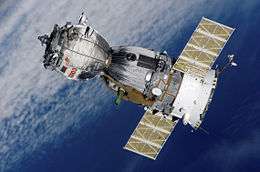Soyuz TM-2
| COSPAR ID | 1987-013A | ||||
|---|---|---|---|---|---|
| Mission duration | 174 days, 3 hours, 25 minutes, 56 seconds | ||||
| Orbits completed | ~2,810 | ||||
| Spacecraft properties | |||||
| Spacecraft type | Soyuz-TM | ||||
| Manufacturer | NPO Energia | ||||
| Launch mass | 7,100 kilograms (15,700 lb) | ||||
| Crew | |||||
| Crew size |
2 up 3 down | ||||
| Members | Aleksandr Laveykin | ||||
| Launching | Yuri Romanenko | ||||
| Landing |
Aleksandr Viktorenko Muhammed Faris | ||||
| Callsign | Taimyr | ||||
| Start of mission | |||||
| Launch date | 5 February 1987, 21:38:16 UTC[1] | ||||
| Rocket | Soyuz-U2 | ||||
| Launch site | Baikonur 1/5 | ||||
| End of mission | |||||
| Landing date | 30 July 1987, 01:04:12 UTC[2] | ||||
| Landing site | 80 kilometres (50 mi) from Arkalyk | ||||
| Orbital parameters | |||||
| Reference system | Geocentric | ||||
| Regime | Low Earth | ||||
| Perigee | 341 kilometres (212 mi) | ||||
| Apogee | 365 kilometres (227 mi) | ||||
| Inclination | 51.6 degrees | ||||
| Period | 91.6 minutes | ||||
| Docking with Mir | |||||
| |||||
Soyuz TM-2 was the spacecraft used to launch a long duration crew to the Soviet space station Mir, which was unmanned at the time. TM-2 was launched in February 1987, and it was first manned spaceflight of the Soyuz-TM spacecraft,[3] and the second manned spaceflight to Mir (the first being Soyuz T-15). The crew of the long duration expedition, Mir EO-2, who were launched by TM-2 consisted of Soviet cosmonauts Yuri Romanenko and Aleksandr Laveykin.
The spacecraft remained docked to Mir, functioning as a lifeboat for the EO-2 crew, until July 1987 when it returned to Earth carrying Laveykin and the two man crew of Mir EP-1. Romanenko later returned to Earth in Soyuz TM-3 at the end of EO-2.
Crew
| Position | Launching crew | Landing crew |
|---|---|---|
| Commander | Mir EO-2 Third spaceflight |
Mir EP-1 First spaceflight |
| Flight Engineer | Mir EO-2 First spaceflight | |
| Research Cosmonaut | None | Mir EP-1 First spaceflight |
Mission parameters
- Mass: 7100 kg
- Perigee: 341 km
- Apogee: 365 km
- Inclination: 51.6°
- Period: 91.6 minutes
Mission highlights
Early in the expedition EO-2, the module Kvant-1 was launched to automatically dock with Mir. The docking system, known as the "Igla system", was not behaving as expected. On April 5 the EO-2 crew retreated to the Soyuz TM-2 spacecraft so that they could escape in the event the module got out of control. About 200 m out, the docking system lost its lock on Mir’s aft port antenna. The cosmonauts watched from within Soyuz-TM 2 as the Kvant/ FSM combination passed within 10 m of the station.[1] Following an emergency spacewalk, Kvant fully docked to the station on April 11.
References
- 1 2 "Mir EO-2". Encyclopedia Astronautica. Retrieved 11 November 2010.
- ↑ "Mir EP-1". Encyclopedia Astronautica. Retrieved 11 November 2010.
- ↑ "Soyuz TM". Encyclopedia Astronautica. Retrieved 11 November 2010.

